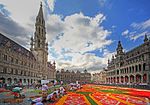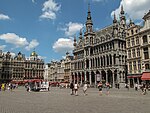Royal Theatre Toone

The Royal Theatre Toone (French: Théâtre royal de Toone, Dutch: Koninklijk Poppentheater Toone), is a folkloric theatre of marionettes in central Brussels, Belgium, active since 1830, and the only traditional Brussels puppet theatre still in operation. Originally founded by Antoine "Toone" Genty in the Marolles/Marollen district of Brussels, since 1966, the theatre has been located at the end of two narrow alleyways, at 66, rue du Marché aux Herbes/Grasmarkt, near the Grand Place. The theatre's current premises also house a tavern and a small puppetry museum. The current director is Nicolas Géal, also known as Toone VIII.The theatre still puts on puppet plays in the Brusselian dialect (also sometimes referred to as Marols or Marollien), the traditional Brabantian dialect of Brussels. Performances are also given in other languages interspersed with Brusselian.
Excerpt from the Wikipedia article Royal Theatre Toone (License: CC BY-SA 3.0, Authors, Images).Royal Theatre Toone
City of Brussels Pentagon (Brussels)
Geographical coordinates (GPS) Address Nearby Places Show on map
Geographical coordinates (GPS)
| Latitude | Longitude |
|---|---|
| N 50.847222222222 ° | E 4.3533333333333 ° |
Address
1000 City of Brussels, Pentagon (Brussels)
Belgium
Open on Google Maps











